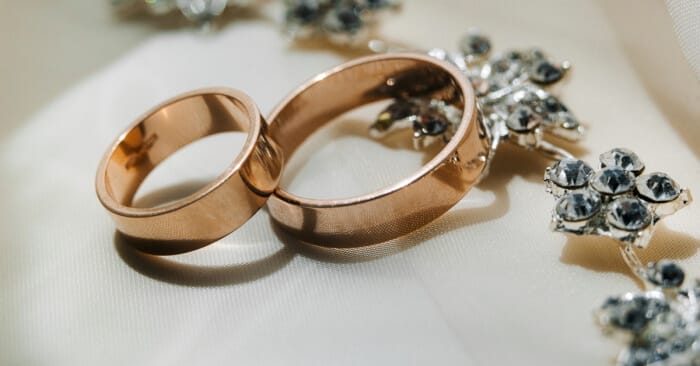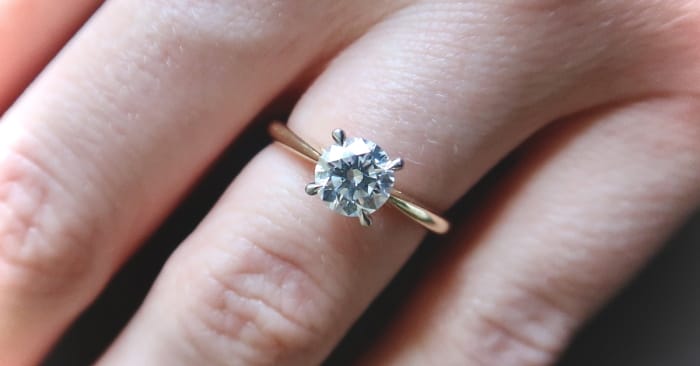The exchange of wedding rings has long been an act that signifies the bond, commitment, and love between two people who want to spend their lives together. But the history of wedding rings and giving jewelry as a gift might surprise you. In ancient times, it was often nothing more than a symbol of ownership.

The Origin of Wedding Rings
The origin of wedding rings is clouded in mystery. Many scholars believe that the tradition started in ancient Egypt and was later adopted by the Greeks, followed by the Romans. However, it’s hard to find conclusive evidence that the tradition started in Egypt.
The history of wedding rings can only be reliably traced as far back as ancient Rome. It does not mean that older civilizations did not wear rings or did not give a ring to a lover. For example, in ancient Egypt, the pharaohs wore rings symbolizing eternity.
According to the Gemological Institute of America (GIA):
“It was the Egyptian pharaohs who first used rings to represent eternity. That’s because a circle has no beginning and no end, and reflects the shape of the sun and the moon, which the Egyptians worshipped. The Egyptians also thought that the open space in the middle of a ring represented a gateway to the unknown.”
Greece and Rome
When Alexander the Great conquered Egypt in 332 BC, the Greeks adopted several Egyptian traditions. It’s believed that Greeks would sometimes give a lover a ring signifying their eternal devotion. Alexander’s empire didn’t last long after his death in 323 BC, but the tradition of giving a lover a ring remained.
The use of rings in marriage ceremonies in Ancient Rome is well documented. It’s widely believed that the Romans inherited the tradition of using rings to signify a bond when they conquered Greece in 31 BC and took control of Egypt.
The original rings used in marriage ceremonies were made from iron or copper, but it didn’t take long for gold rings to become popular. It became a norm in ancient Rome for a woman to have two wedding rings – an iron and a gold one. The iron ring was worn at home and the gold one in public or on special occasions.
In addition, it became a custom for women to wear their wedding ring on the fourth finger of the left hand. People believed the ring finger, as it’s called today, contained a “vena amoris” (Latin for “vein of love”) that ran directly to the heart.
The Middle Ages
During the early Middle Ages, getting married in countries such as England was relatively easy. Both parties had to give each other their consent and it was common practice for the groom to give his bride a wedding ring. There was no requirement for witnesses or for a priest to conduct the ceremony.
Around 850, Pope Nicholas I officially declared that engagement rings (often called betrothal rings) be given as a declaration of the intent to get married. They could no longer be used to signify a business relationship or ownership.
But it was only in the 12th century that the Roman Catholic Church formally defined marriage as a holy sacrament sanctioned by God.
Diamond engagement and wedding rings only appeared for the first time in the 15th century. In 1477, Archduke Maximillian of Austria commissioned the first diamond engagement ring on record for his betrothed, Mary of Burgundy. It ignited a trend for diamond rings among European aristocracy and nobility, according to the American Gem Society.
Fast Forward to the 20th Century
By the 20th century, it was customary for a groom to give his bride a wedding ring. Although the Christian church encouraged men to wear wedding rings as well, it wasn’t common practice until the 1940s.
It was also during the 1940s that diamond engagement rings became popular, thanks to a smart marketing campaign by the world’s leading diamond company De Beers. Up until then, diamonds were just one of many gems that could be used for an engagement ring.

In 1947 De Beers changed how we perceive diamonds when they launched their ad slogan “a diamond is forever.” By the 1950s many women expected to receive a diamond engagement ring and “diamonds are a girl’s best friend” sung by the legendary Marilyn Monroe only added fuel to the fire.
According to statistics, the share of brides who received a diamond engagement ring in the United States increased from 10% in 1939 to 80% by 1990.
That's a Wrap
Diamond engagement rings and the exchange of wedding rings during a marriage ceremony have become entrenched in our society.
If you’re shopping for an engagement or wedding ring, visiting a pawn shop first is a smart move. Saving money by not buying rings at inflated prices at a jewelry store is just one of the reasons. Pawn shops have a lot more to offer than many people expect.
If you’re looking for an engagement or wedding ring, we invite you to visit one of our five locations in San Francisco and Los Angeles.
Call us at (800) 888-7296 if you have any questions. We will gladly assist you.

